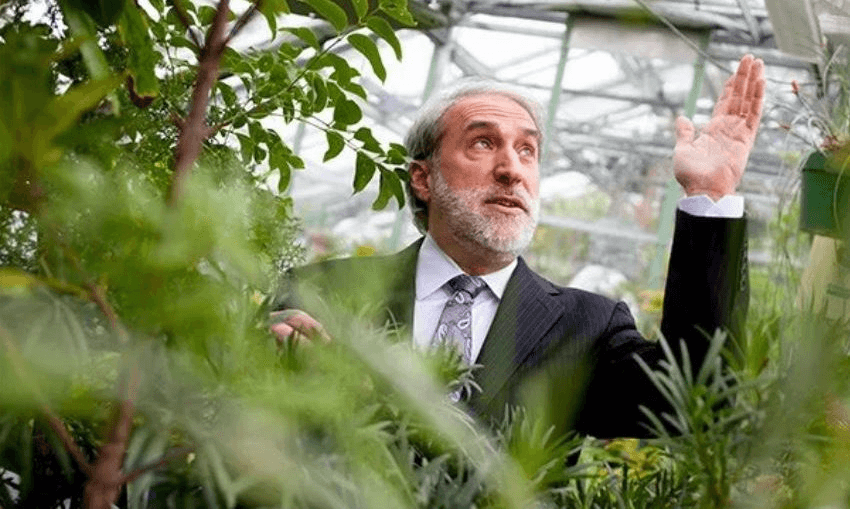As the world’s population continues to rise, energy and food needs are both projected to grow beyond the capacity of existing technologies. Harvard chemist Dan Nocera anticipates that only a major shift will get us through, and he thinks NZ could play a pivotal role, writes Vernoika Meduna
Take sunshine and water and power the world, cheaply. That’s the mission Harvard chemist Dan Nocera has set himself and, over the past decade or so, he has developed several game-changing technologies towards this goal. This week, he’s in New Zealand to meet with politicians, officials and scientists to introduce the latest version of his bionic leaf – a high-tech replica of the chemical process plants use to grow.
During photosynthesis in a real leaf, the first step is to soak up the energy of the sun to split water into oxygen and hydrogen. Nocera developed an artificial leaf using a silicon wafer, which absorbs the sun’s energy, sandwiched between coats of chemical catalysts that use that energy to do the water splitting. The resulting hydrogen gas could already be used as a fuel, but it is difficult to store. So Nocera didn’t stop there.
In nature, the next step in photosynthesis is to pull carbon dioxide from the air and to combine all ingredients into sugars that fuel a plant’s growth. Nocera teamed up with a biologist and merged the artificial leaf with bacteria that had been genetically engineered to produce biofuels instead of sugars. But Nocera didn’t stop there, either.
The water-splitting part of the reaction doesn’t require clean water. It runs just as well in seawater, or even urine, and can be used to produce both freshwater and fuel. The bionic leaf bacteria are tuneable, genetically speaking, and can be set to produce a suite of biofuels – and they do so at a much higher efficiency than plants. With each step in the development, Nocera’s team could see an ever widening range of potential applications. The latest project in the Nocera lab is to use the bionic leaf to produce fertiliser instead of biofuels, and to help forge a new kind of distributed agriculture that could boost yields on subsistence farms.
Nocera’s primary motivation in all of this is not to save the planet. That’s just a welcome co-benefit of his key goal to help people in poorer countries to gain better and cheaper access to energy and food.
“If you have poverty, it’s impossible to have a sustainable planet,” Nocera says. “The only way to head off really catastrophic consequences for a sustainable earth is to eliminate the imbalance of poverty. You can do that by providing people with food, water and mostly energy.”
As the world’s population continues to rise, energy and food needs are both projected to grow beyond the capacity of existing technologies. Nocera anticipates that only a major shift will get us through.
He shares a story from the 1890s, when delegates from across the globe gathered in New York for the world’s first urban planning conference. They were worried about horse manure, predicting a major health hazard as more and more people used horse-drawn carriages. They pictured manure piling up three storeys high, and they couldn’t think of a solution.
“What they didn’t realise is that the automobile was being invented and that this problem was going to go away.”
Fossils fuels are today’s horse manure, but distributed, efficient solar-powered energy generation could be the technological shift required to move beyond them.
NASA is already showing interest in the bionic leaf as a clean technology for space exploration, but Nocera is more interested in getting it to people who need it most. And he’s giving it away.
“I can control my own IP,” he says. “Harvard’s view on IP is that they own it for the betterment of humankind, so I’m under no pressure to have a start-up company and make money from it.”
Nocera has passed on the IP to the bionic leaf to an Indian institute in Mumbai, which is now attracting investment from Indian food and energy companies to scale up and prototype the technology. The original discovery is protected by patents, but he says neither he nor Harvard university should be “skimming” money. “We’re meant to create knowledge and discovery. It’s not my role to become rich from it. I’m not assuming any of the risks that come with the scale-up process.”
As for developed countries generally, and New Zealand specifically, Nocera – a member of the MacDiarmid Institute’s International Science Board – suggests there’s room to fill the vacuum created by the US. “With America shirking its responsibility, it’s a great time for other places to step up. New Zealand could take a leadership position [in renewable energy]. With the high hydro-electric base, New Zealand can get to near zero carbon better than any other country.”
He sees the biggest barrier in the existing centralised infrastructure of power generation.
In contrast, the bionic leaf is the “ultimate distribution model”.
In time, he thinks energy security concerns will play in his favour. “We don’t know how much we are at the mercy of some people who could take an electricity grid out with a few computer codes. There will be reasons other than environmental ones that will drive distributed energy supply.”
The Spinoff’s science content is made possible thanks to the support of The MacDiarmid Institute for Advanced Materials and Nanotechnology, a national institute devoted to scientific research.

